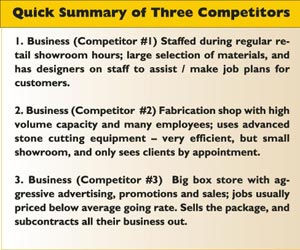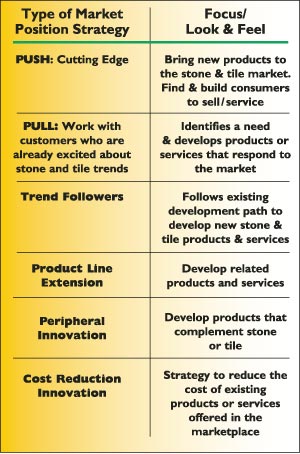Stacking Up Competitors and Identifying Your Market Position
Michele Farry
Humblestone
We ended my last SRG (March 2017) article thinking about our competitors, and we will discuss that in more detail this month.
To recap, your first challenge at the beginning of this series (Feb 2017) began with describing your consumer clients and compiling information. The next step was separating our consumers by independent (A) private customers versus business (B) clients. I showed you what a sample chart looks like for a clear visual on how our customers can break down. Moving on, we briefly touched on the value of follow-up questions and how to create a simple survey. If you haven’t read these articles please go back and take a look; they will help you gain a better picture of your market, and help you target the customers that are a good fit for your company’s growth.
When you created the competitor profile table, did anything stand out? Was this exercise uncomfortable? In my past conversations with some stone fabricators and tile installation companies, they felt this exercise seemed like a waste of time. Revelations on what could be advantages by your competitors certainly can be discouraging. During this step, underlying worries can come to the surface, like, How will I continue to compete in the busy stone and tile marketplace? It would be easy and acceptable to stay unsure and just keep your nose to the grindstone.
It’s not uncommon for some businesses to be overconfident, but can you back up why you have the edge?
Being an informed business owner helps you to stay focused and awake in whichever path you choose. Knowing your competitors keeps your business more solid and stable, and actually relieves anxiety about competitors while balancing overconfidence. Let us take the strengths and weakness of your competitors and plan how to compete against it with your strengths and weaknesses.
I would like you to look at your competitors profile list and choose three competitors to start. You can always add more or even separate your competitors into groups of competitors like kitchen and bath showrooms vs. independent fabricators into different categories, but for now we will look at just three basic competitors in more detail.
I strongly suggest that you now take a moment to break down your business and create a profile on yourself. List what strengths you have and where you excel. Take a few moments and reflect on how your business stacks up. Don’t forget to identify your weaknesses. Your consumers and business clients do have different needs like price, accessibility, services or promotions that you have identified. What can you anticipate your three competitors offer that could have an impact on your business? Knowing who your customers are from your customer profile, connect the information. Do any of these competitors provide needs that motivate your customers and where can you improve?

It would be helpful to understand a little bit about your market position. Whether you realized it or not, when you did your first job or opened your shop your brand/business chose a market position. Where your business fits as opposed to your competitors, communicates with your consumers how you will provide and sell your services. It could be price, selection, location, size of your shop, custom fabrication or services etc. This all gets laid out by what market position you have taken. In shaping and guiding our consumers toward us, we subconsciously or intentionally motivate our customers and refine who our customers will ultimately be. Your business, then, has the burden of proving the benefits over your competitors through price, selection, location etc. Are you a pusher, puller, trend follower or innovator?
This chart shows examples of different segments of market position:

Do Your Research
Your completed business profile will enable you to use the information you are learning. Look at the market strategy chart and see where how your business fits in the layout. In the next article I will give examples of how you can take your position in the marketplace, determine what your market strategy already is, and expand on it. We will build on how you can stand out from your competitors while meeting your consumer’s expectations.
Michele Farry co-owns Humblestone and is passionate about entrepreneurship and small business growth. Michele has received awards for her work with profit-based and non-profit charity organizations.